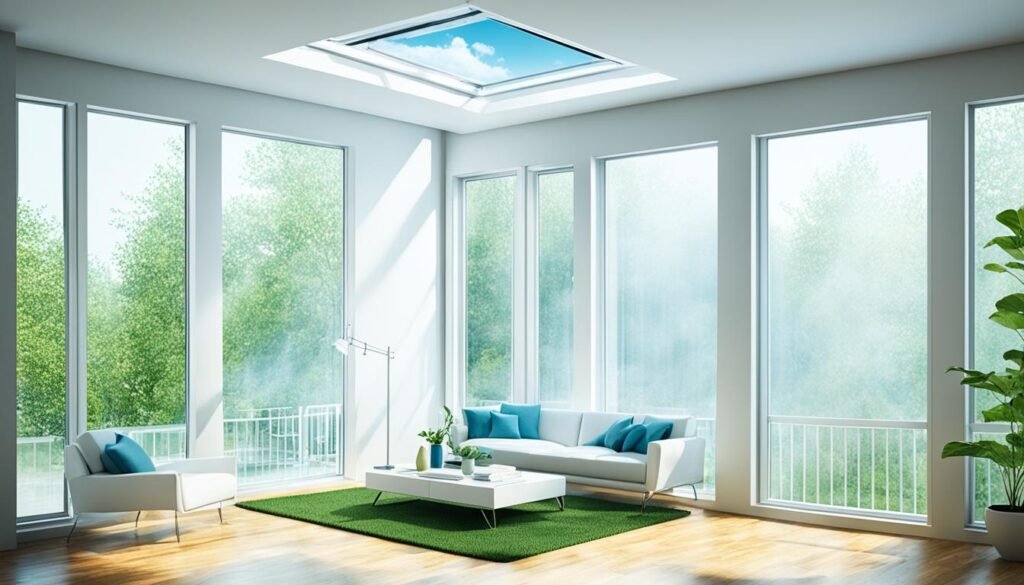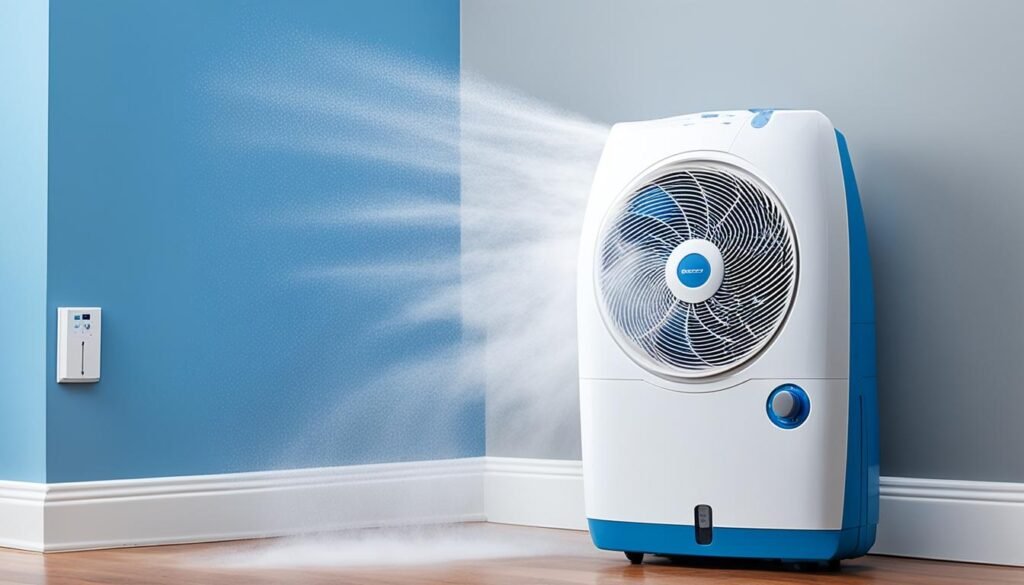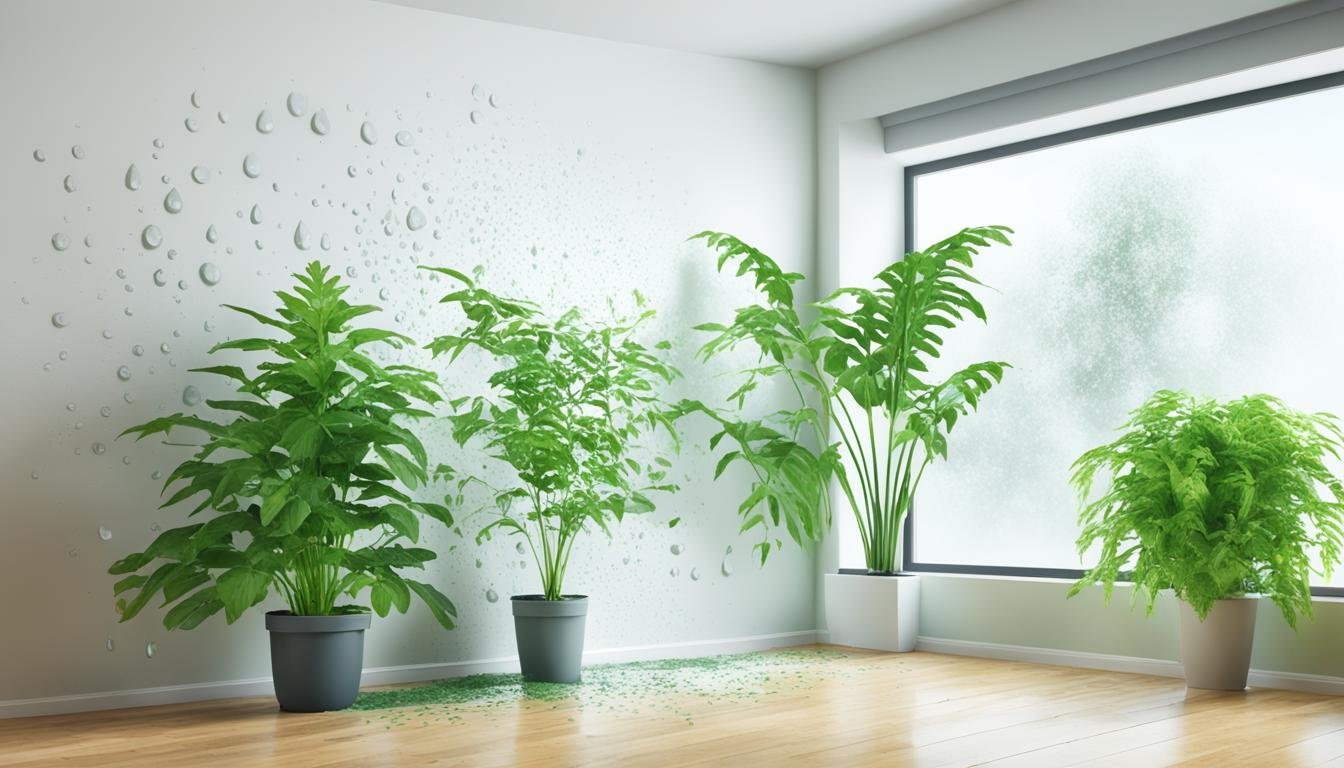Did you know, nearly half of US homes battle with high indoor humidity? This is a big problem that leads to discomfort and damage. Signs like condensation, mold, and bad smells show up. If you notice these signals, it’s time to take action. This way, you can keep your space healthy and safe for a long time.
Condensation happens when warm, wet air meets cold surfaces. This creates liquid water. Mold loves moisture and shows up on walls and ceilings. This makes your home smell musty. Dealing with the excess moisture is key. This can prevent and get rid of mold. You can use DIY ways or call a professional if needed.
Key Takeaways
- High indoor humidity can lead to condensation, mold growth, and unusual odors
- Addressing the source of unwanted moisture is crucial to preventing and eliminating mold issues
- DIY methods and professional assistance are available for managing indoor moisture levels
- Ideal relative humidity levels in homes should be around 30 to 60 percent
- Proactive maintenance of HVAC systems can prevent malfunctions that contribute to high humidity
Effective Ventilation Techniques
Good ventilation is key to a healthy, cozy indoor space. It’s about keeping the air moving and managing moisture. This prevents bad stuff from building up in the air, keeps humidity in check, and makes your home a better place to be.
Utilize Fans for Air Circulation
Fans aren’t just for cooling you down. They fight against too much moisture in the air. They do this by moving the air around, helping wet spots dry out. This stops mold and mildew from growing in areas like the kitchen, bathroom, and basement. So, it’s smart to have fans there to keep the air fresh and dry.
Proper Ventilation in Moisture-Prone Areas
Rooms that get wet easily need extra care when it comes to air. After a shower, let the bathroom fan run for 10 more minutes to clear out leftover steam. But, don’t forget to turn it off after a while. We don’t want the air to get too damp. Always blow the wet air outside, not back in your house. If there’s no fan, open a window for a while to let new air in.
| Ventilation Method | Key Benefits | Potential Drawbacks |
|---|---|---|
| Exhaust Ventilation | – Easy and cheap to add – Takes bad air out of the house | – Might make your energy bills go up |
| Supply Ventilation | – Lets you control how air moves – Stops smoke or gas from going back in | – Could make a house too damp in cold places |
| Balanced Ventilation | – Works well in any weather – Brings in and takes out air in equal amounts | – Costs more to put in and run |
| Energy Recovery Ventilation | – Saves about 70-80% of the energy in the air – Keeps the air from getting too humid or dry | – Best if you live in a place with very cold winters or high heating costs |
Use these strategies to make your home better for breathing and living. They keep the air fresh and dry, stopping mold and mildew growth. This means fewer problems with air quality.

Methods to Remove Moisture from Your Home
Keeping your home’s moisture levels in check is key for a healthy and comfy space. Invest in a dehumidifier to tackle too much moisture. Also, managing your air conditioning well is important.
Invest in a Dehumidifier
A dehumidifier is great for lowering humidity. It takes extra moisture from the air. By doing this, it prevents mold, mildew, and other problems.
When buying a dehumidifier, look at the room size it can handle. Also, check energy use and extra features. Brands like Midea, Pure Enrichment, and Waykar have models for all needs.
Manage Your Air Conditioning System
Your AC unit doesn’t just cool, it pulls moisture out of the air. Running the AC earlier in the day helps keep humidity low. This makes your home more comfortable.
Keep your AC system in top shape by cleaning air filters and getting regular check-ups. If you face heavy humidity or AC problems, get a pro’s help.

Using a dehumidifier and taking care of your AC are great ways to fix too much moisture. Remember, the right humidity levels help your home and your family stay healthy.
Conclusion
Keeping your home’s humidity at the right level is vital. It makes the indoor environment comfy and healthy. You should use good ventilation, buy effective dehumidifiers, and keep your HVAC system well-maintained. This will help you control moisture. It stops things like mold and other damage.
To get rid of high humidity, you have to go to the source. Sometimes, you might need a professional’s help. They can figure out the best ways to fix humidity issues in your home. Doing this, along with keeping an eye on things, will make your home dry, cozy, and energy-saving. It’s good for the air you breathe and meeting your home improvement goals.
Work on managing humidity and controlling moisture to make your home better. This can increase comfort, health, and how long your home lasts. Do what it takes to keep humidity at ideal levels. You’ll be happier with your home’s environment and sustainability.
FAQ
What are the common signs of high indoor humidity?
How can fans help combat humidity in my home?
Why is proper ventilation crucial for managing humidity?
How can a dehumidifier help reduce humidity in my home?
What role does an air conditioning system play in humidity management?
When should I consider consulting a professional for humidity issues?
Source Links
- https://www.assuredcomfort.com/blog/2020/october/10-simple-tips-to-remove-excess-humidity-from-my/
- https://www.forbes.com/home-improvement/interior/lower-humidity-in-house/
- https://www.amfam.com/resources/articles/at-home/how-to-dehumidify-your-home
- https://www.ncbi.nlm.nih.gov/books/NBK143947/
- https://www.lowes.com/n/how-to/controlling-moisture-and-humidity-in-the-home
- https://www.energy.gov/energysaver/whole-house-ventilation
- https://www.4feldco.com/articles/how-to-get-rid-of-moisture-problems-in-the-home/
- https://www.homesandgardens.com/life-design/how-to-reduce-your-homes-humidity
- https://www.wikihow.com/Dehumidify-a-Home
- https://generation3electric.com/7-ways-to-lower-humidity-in-your-home/
- https://www.floridarealestatecentral.com/blog/indoor-humidity-management-guide/
- https://www.thecomfortauthority.com/how-to-dehumidify-a-room/


